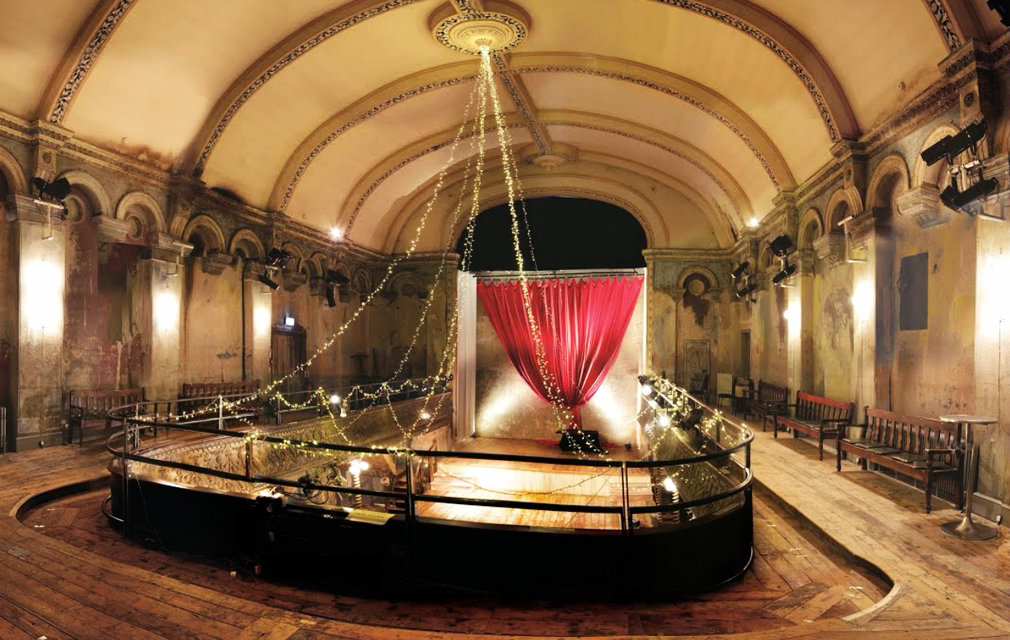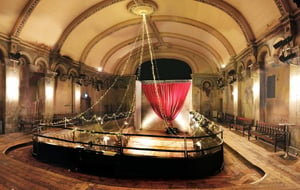Wilton’s produces imaginative, distinctive work that has roots in the early music hall tradition but reinterpreted for an audience of today, which means presenting a diverse and distinct programme including opera, puppetry, classical music, cabaret, dance, and magic. Situated at the heart of the historic East End within easy walking distance from The Tower of London, the River Thames and the City, it is a focus for theatrical and East End history, as well as a living theatre, concert hall, public bar and heritage site.
The venue recently underwent an extensive programme of restoration work. The theatre did not close at any point during the building works: instead running an interim arts programme called The Chrysalis Club. The award-winning spaces reopened in October 2015.
Once one of London’s leading Grand Music Halls, by 1964 Wilton’s Music Hall was destined for demolition. It took decades of passionate campaigning to bring the building back to life and then to make it safe. Conservative repair was finally completed in October 2015 and we look back at the long journey it took to save Wilton’s.
Wilton’s Music Hall had been taken over by the Wesleyan East End Mission in 1888, transforming its reputation as a centre of vice to one of moral guidance. Staying until 1956 the Mission was Wilton’s longest serving tenants.
The charitably funded Mission could not maintain the building and sold the decaying structure to Coppermill Rag Merchants who used the hall as a warehouse for sorting materials.
London’s East End had been badly damaged in the Blitz; much of the surviving buildings were demolished during subsequent slum clearances. This notice lists Wilton’s at Nos. 1/4 Grace’s Alley as scheduled for demolition.
Although badly damaged, Wilton’s was one of few surviving Victorian music halls. Its significance and looming destruction alarmed preservationists and veteran performers.
Building surveyor and theatre historian John Earl took an early interest in Wilton’s and prepared a briefing to combat the London County Council (LCC) at a planning meeting to discuss preservation or demolition
Writer and broadcaster John Betjeman, as a well-known public figure, presented the case and successfully convinced the LCC that Wilton’s was worth preserving.
The LCC, soon to be renamed the Greater London Council (GLC) took ownership of the site.
Wilton’s survived but over the following years almost the entire surrounding neighbourhood was razed, with few immediate replacements.
The Campaign Begins
Spike Milligan, the famous comedian and writer, took the lead in campaigning for Wilton’s in 1970. The GLC owned the site but responsibility for reinvigorating Wilton’s would rely on external groups.
Spike wrote to the great and the good to highlight Wilton’s plight. This cheeky message to HRH Prince Charles eventually convinced him to become the first patron in 1971; a position he revived in 2006.
As a successful television star himself, Spike convinced the BBC Head of Comedy, Michael Mills, to produce a television special ‘The Handsomest Hall in Town’ in 1970, featuring major variety stars of the day.
The production crew were able to make cosmetic improvements to the hall but the building remained in a perilous state. Plans were considered for full restoration but momentum could not be sustained, nor sufficient funds raised.
Grand Plans
In 1972 after the initial surge of interest lapsed, Peter Honri took charge of the campaign for Wilton’s. Honri had music hall in his blood, as the grandson of music hall star Percy Honri. Along with actor Marius Goring, Honri established the first Trust for the Restoration of Wilton’s. He wrote tirelessly to the leading lights of entertainment to raise awareness of Wilton’s struggle.
The Trust drew up plans which would include a school of music hall. A disagreement with the GLC erupted when the Trust was denied the lease in favour of the ‘socialist’ Half Moon Theatre company.
The bitter fight for control delayed any substantial repairs to the building but eventually put the lease back in the hands of the Trust who wished to promote Wilton’s as a centre for variety entertainment
The battle for Wilton’s had split the Trust members and in 1978 new plans were drawn up on a smaller scale by Peter Honri and architect Peter Newson.
Peter Honri wrote an ‘Artistic Blueprint for Wilton’s’; the first document to look at programming the venue again as a theatre. It was strongly devoted to variety entertainment and catering in the spirit of the original.
Peters Honri and Newson, enlisted the help of Peters Drew who was redeveloping the nearby Katherine Docks and Delaney, Vicar at the historic All Hallows by the Tower. The group created the new London Music Hall Protection Society.
A launch party was held at All Hallows by the Tower and the project began to build momentum.
Rev. Peter Delaney introduced Liza Minnelli to Wilton’s. She went on to host a fundraising gala in support of Wilton’s at the Café Royal.
The building was too dangerous to host performances so fundraising events had to be held elsewhere.
A series of events: Wilton’s on the Green, on the River, at the NFT, raised awareness but only a small amount of revenue.
Eventually sufficient funds were raised to do initial repairs, first to the exterior of Wilton’s, and a new charitable London Music Hall Trust was established.
The auditorium roof was repaired but the building still remained unsafe for performances.
By the mid-1980s momentum had slowed and many of the original Trust founders were no longer involved with the project. The new Trust changed direction from fundraising to more commercial activities, inspired by the rapid redevelopment of London’s Docklands.
New proposals were drawn up which looked less at the restoration of Wilton’s and instead at the redevelopment of the area as a themed retail centre called Wilton’s World.
Although Wilton’s could not be used for live performance it was often used as a location for film, television and music videos. The risqué video for Frankie Goes to Hollywood’s Relax was banned by both BBC and MTV.
Whilst the building could be made to look glamorous on screen, the reality was that the structure and especially the front houses were deteriorating.
Wilton’s World never developed beyond a concept and income relied on film shoot hires and occasional tours of the derelict site.
Wilton’s runs a popular theatrical programme, as well as learning and outreach programme, activites and history tours.
As well as hosting events, filming and community groups.
And the Mahogany Bar serves guests every night of the week, a suitable end to 50 years of fighting for survival.

